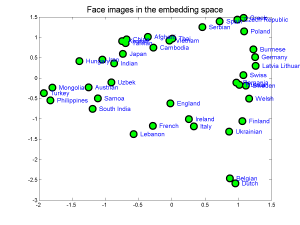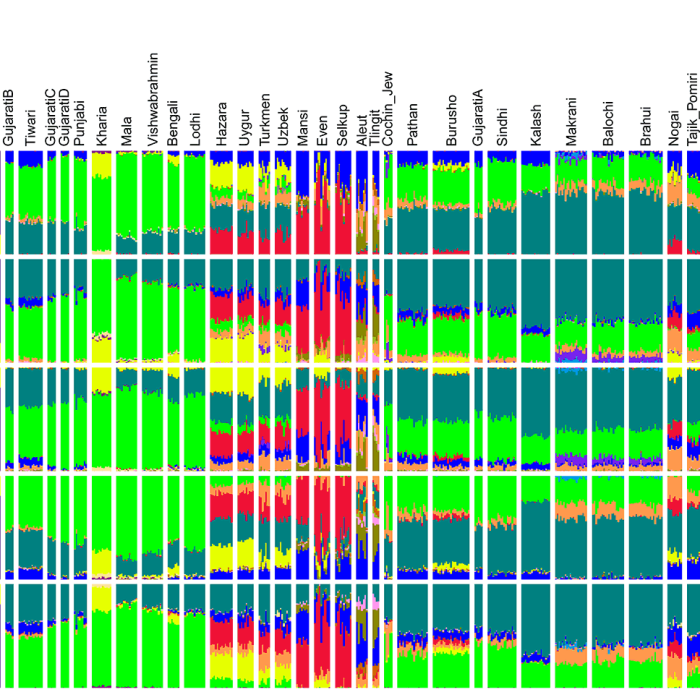“White” is a nebulous category. “Black” is actually easier to define, because there’s a pretty hard boundary (the Sahara) between black Africa and everywhere else. To be fair, there are also groups like the Bushmen (who are more tawny brownish,) and the Pygmies who are genetically separate from other sub-Saharan Africans by over 100,000 years, but these are pretty small on the global scale. But “whites” and “Asians” occupy the same continent, and thus shade into each other.
If we use a strictly skin tone definition (as the world “white” implies) we can just pull up a map of global skin tone variation:

Of course, this implies that either Spaniards and Finns aren’t white, or Chinese and Eskimos are. Either way is fine, of course, though this would contradict most people’s usage. (And I kind of question that data on the Finns:

These composites of faces from around the world offer us some more data, though depending on how they were made, they may not accurately reflect skin tone in all countries (ie, if the creator relied on pictures of famous people available on the internet, then these will reflect local beauty norms than group averages.)
(Plus, I wonder why the Romanians are pink.)
J. B. Huang has taken some of the Eurasian faces from this set and gone through the effort of trying to quantitize their shapes, as displayed in this graph (at least, that’s what I think they’re doing):
 Interestingly, while some of the faces cluster together the way you might expect–China, Taiwan, Korea, and Japan are all near each other, as are Belgium and the Netherlands–many of the groupings are near random, eg, Mongolia, Turkey, and the Philippines. Hungary and Austria are closer to India and Japan than to Poland or Finland. The European faces are all over the map.
Interestingly, while some of the faces cluster together the way you might expect–China, Taiwan, Korea, and Japan are all near each other, as are Belgium and the Netherlands–many of the groupings are near random, eg, Mongolia, Turkey, and the Philippines. Hungary and Austria are closer to India and Japan than to Poland or Finland. The European faces are all over the map.
Maybe this doesn’t mean anything at all, or maybe it means that there’s a lot of variation in European faces.
This is actually not too surprising, given that modern Europeans are genetically descended from three different groups who conquered the peninsula in successive waves, leaving more or less of their DNA in different areas: the hunter gatherers who were there first, followed by farmers who spread out from Anatolia (modern Turkey,) followed by the “Indo-Europeans” aka the Yamnaya, who were part hunter gatherer (by DNA, not profession) and part another group whose origins have yet to be located, but which I call the “teal people” because their DNA is teal on Haak’s graph.
Oh yes, we are getting to Haak.

This isn’t the full graph, but it’s probably enough for our purposes. The European countries show a characteristic profile of Orange, Dark Blue, and Teal. (By contrast, the east Asian countries, which cluster closely together on the facial map, are mostly yellow with only a bit of red.)
Obviously DNA isn’t actually colored. It’s just a visual aid.
Haak’s graph makes it fairly easy to rule out the groups that are definitely different (at least genetically.) The American Indians, Inuit, West Africans, Chinese, and Aborigines are distinctly out. This leaves us with Europe, the Middle East, North Africa, India, and parts of central Asia/Siberia:
The Orange-centric region, which Haak et al arranged to display the movements of the Anatolian farmer people.
The heavily teal Indian section (The middle part, from Hazara-Tlingit, are obviously not Indian).
 And finally some Siberian DNA.
And finally some Siberian DNA.
Now, I could stare at these all day; I love them. They tell so many fascinating stories about people and where they went. Of the three ancestries found in Europeans, the oldest, the dark blue (hunter-gatherers,) is found throughout India, Siberia, and even the Aleutian islands (though I caution that some of this could just be because of Russians raping the Aleuts back in the day.) The dark blue appears to hit a particular low point in the Caucuses region, which of course is about where the teal got its start.
The orange–Anatolian farmers–shows up throughout the Middle East and Europe, but is near totally absent in India and Siberia. (Not much farming in Siberia!)
At a lower resolution (not pictured,) India, central Asia, and Siberia appear to have a mix of–broadly speaking–“European” and “Asian” ancestry. (Not too surprising, since they are in the middle of the continent.) Obviously the middle of Asia is a big crossroads between different groups–red (Siberian) yellow (east Asian) teal and dark blue, and bits of the same DNA that shows up in the Eskimo (Inuit) and Aleuts.
But this is all kind of complicated. Luckily for us, this is only one way to visualize DNA–I’ve got others!

If you’re not familiar with these sorts of trees, the basic story is that geneticists gathered DNA samples (from spit, I think, which is pretty awesome,) from ethnic groups from all over the world, and then measured how many genes they have in common. More genes in common = groups more closely related to each other. Fewer genes = more genetic distance from each other.
Since different genetic samples and computer models are different, different teams have produced slightly different genetic trees.
Note that since the tree is constructed by comparing # of genes two groups have in common, a group could end up in a particular spot because it is descended from a common ancestor with other nearby groups, or because of mixing between two groups. Ashkenazi Jews, for example, cluster with southern Europeans because they’re about half Italian (and obviously half ancient Israeli.) Here’s another chart, giving us another perspective:

This chart also shows us genetic differences between groups, with strong clustering among African and East Asians, respectively, and then a sort of scattered group of Europeans and Indians (South Asians.)

Neither of these graphs shows Siberians or central Asians in great detail, because they are tiny groups, but I think it’s safe to say the Siberians at least cluster near their neighbors, the other Asians and far-north Americans.
The central and south Asians, though, are quite the interesting case!
Between archaeology and genetics, we’ve been able to trace the path of human expansion, from central Africa to the world:

Since this post is already image heavy, here is a graph showing finer detail on European and North African groups, Moroccans, (Berbers), Aleut woman, Sardinians, Sami (Lapps), Iranians, Gujarati, (another), Dravidian, Brahmin, Dalits, Altai, Uyghur, Selkup. (Look at the pictures!)
Well, ultimately, there’s no hard division between most ethnic groups or races–you can draw dividing lines where you want them. The term “white” implies dermal paleness, of course, so you may prefer a narrower definition for “white” than “Caucasian.” Greater minds than mine have already covered the subject in more authoritative detail, of course. I merely offer my thoughts for entertainment.


[…] Source: Evolutionist X […]
LikeLike
Geography nitpick: Most of Finland is in the fully white category. That’s Lapland, and mostly the Russian part at that, that’s in the slightly darker category on that map.
LikeLike
Thanks!
LikeLike
[…] EvolutionistX […]
LikeLike
The fact that you understand the true origins of the ‘Aryans’ (not blonde-haired and blue-eyed as Nordicist proles would like you to believe) makes me like your blog even more.
I need to finish the Haak paper I should get around to that this weekend.
LikeLiked by 1 person
Thanks.
Etymologically, Aryan = Iranian. I used to be under the mistaken impression that the Iranians had named their country after the ethnic group, but this is backwards; “Aryan” is derived from the name Iran.
I find this is amusing, given current politics.
I’m sure there are some blond, blue-eyed Iranians, but it seems pretty rare. ;)
LikeLike
I haven’t been blonde since age 2 or 3, but definitely blue eyed. In high school I had an Iranian friend who was living with her American cousins, and once when her mom was visiting, thet dressed me up in an ethnic costume, and they were in agreement that I looked Kurdish. I know that we’re not “supposed” to care if people look like us regarding international politics, but I think the fact that Kurds look like a lot of white Americans just wearing “ethnic costume” doesn’t hurt as far as gaining sympathy…
LikeLike
[…] Thursday, she attempts to answer So who is White? She pulls out the DNA maps (of course). Pretty […]
LikeLike
Maybe we should stop saying White and instead say another term. That way, we can acknowledge the populations from Spain to North Africa to North India belong to the Caucasoid race while still being carved into subgroups.
LikeLike
I think some people just divide “Caucasian” into “light Caucasian” and “dark Caucasian.” “White” seems like a word we got used to using in the American context, where it was relevant, but only maps approximately to the global context.
LikeLike
[…] Indians, though they clearly live in Asia, are part of the Caucasian clade because they are more closely related to Middle Easterners and Europeans than Chinese people. As a result, Indians were–for a while—recorded as […]
LikeLike